Here at Great Stems we grow dill, partly for cooking but mostly for wildlife.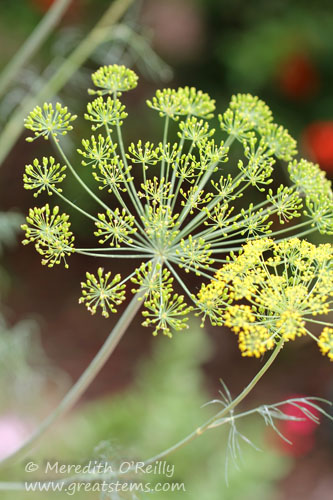 It being May in Texas now, this cool-season herb is overgrown in our garden and not as pretty as it once was.
It being May in Texas now, this cool-season herb is overgrown in our garden and not as pretty as it once was. 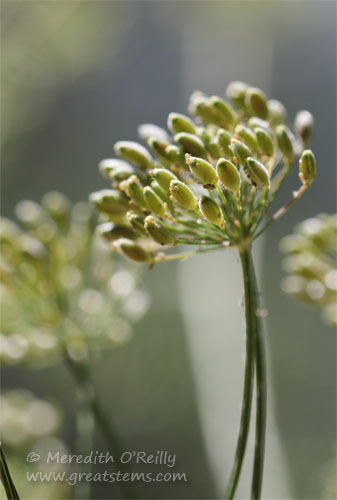 The blooms are giving way to seeds, but that’s not the problem. Aside from being long and lanky, much of it is now covered in aphids.
The blooms are giving way to seeds, but that’s not the problem. Aside from being long and lanky, much of it is now covered in aphids.
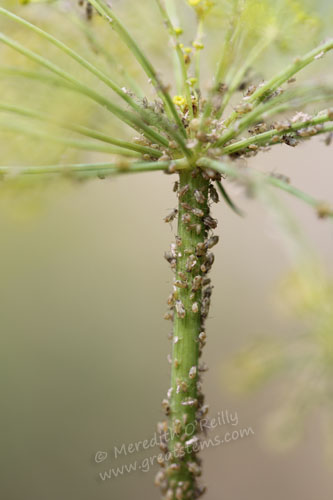 These pest bugs seem to suddenly show up by the hundreds, thanks to females that can produce live young without the presence of a male (when fall weather approaches, the females will produce males to allow the formation of eggs for overwintering). The aphids aren’t noticeably affecting the dill, but the tiny pests and plant legginess made me long to at the very least give the plant a good trim. But as soon as I took a closer look at the plant, I ceased the consideration of that idea — the dill is supporting a beautiful population of wildlife I do want.
These pest bugs seem to suddenly show up by the hundreds, thanks to females that can produce live young without the presence of a male (when fall weather approaches, the females will produce males to allow the formation of eggs for overwintering). The aphids aren’t noticeably affecting the dill, but the tiny pests and plant legginess made me long to at the very least give the plant a good trim. But as soon as I took a closer look at the plant, I ceased the consideration of that idea — the dill is supporting a beautiful population of wildlife I do want.
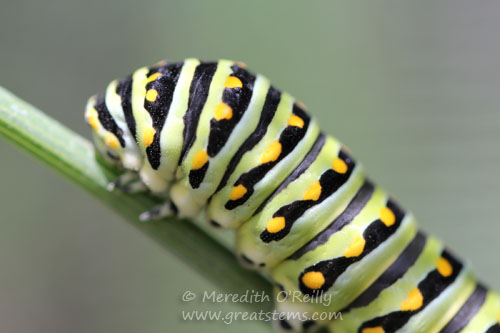 The biggest are the Black Swallowtail caterpillars. Gorgeous, they are.
The biggest are the Black Swallowtail caterpillars. Gorgeous, they are.
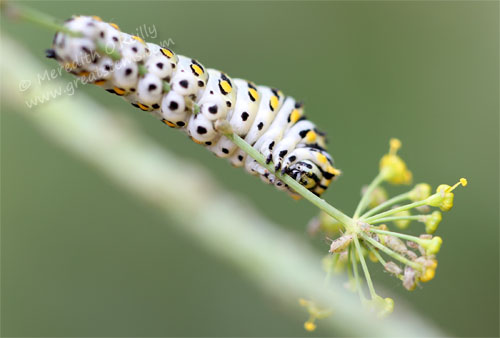
Anyone else adore the little gripping legs of caterpillars? Those stubby-looking ones in the abdominal area are called prolegs, but they aren’t true legs. The true legs are up near the head, in the thoracic area, and those are the legs that will be retained for adulthood. See them? Back at the other end, on the terminal abdominal segment, some caterpillars (including Black Swallowtails) and other insect larvae have an additional pair of prolegs, called anal prolegs.
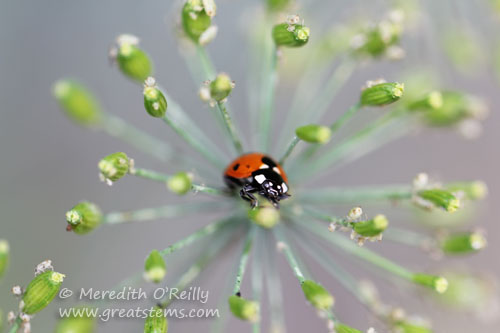 Lady beetles, popularly called ladybugs, dominated the rest of the dill. They are fierce consumers of aphids, and they have found quite the feast on my overgrown herbs.
Lady beetles, popularly called ladybugs, dominated the rest of the dill. They are fierce consumers of aphids, and they have found quite the feast on my overgrown herbs.
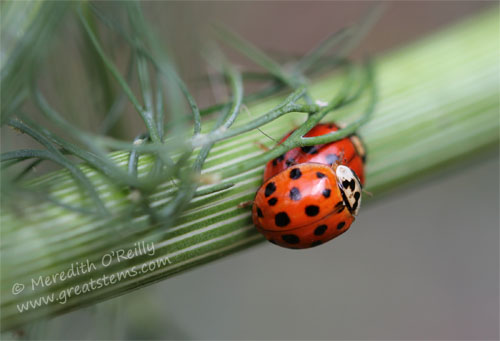 Many male and female lady beetles have paired up, and “in the mood,” they’ve been busy.
Many male and female lady beetles have paired up, and “in the mood,” they’ve been busy.
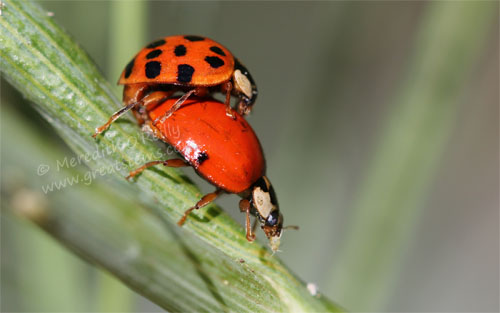 Actually, the females didn’t really stop to mess around, so to speak. The one above, for example, kept eating aphid after aphid, regardless of the male attached to her.
Actually, the females didn’t really stop to mess around, so to speak. The one above, for example, kept eating aphid after aphid, regardless of the male attached to her.
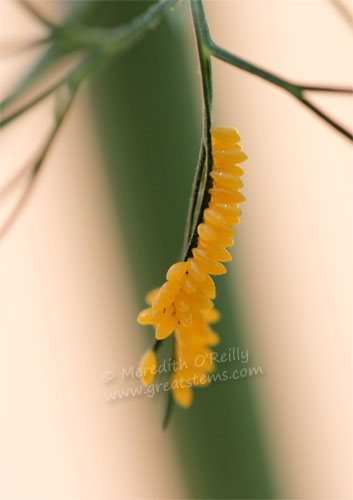 The result of happy lady beetle love? Happy lady beetle eggs, and lots of them.
The result of happy lady beetle love? Happy lady beetle eggs, and lots of them.
Edit: I’m fairly confident that most of these lady beetles are the darn invasive variety, Harmonia axyridis, the very ones responsible for the decline of many of our native species. Frustrating. But let me continue, as the basic concepts I talk about here are still the same.
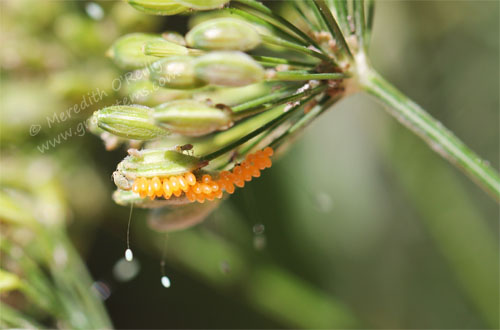 Here you can see both lady beetle eggs (the orange ovals) and lacewing eggs (the individually placed white eggs dangling from threads). I hope the lady beetle larvae emerge first and then skedaddle away before the voracious lacewing larvae arrive. But I’m not too worried, as there are plenty of aphids for them all.
Here you can see both lady beetle eggs (the orange ovals) and lacewing eggs (the individually placed white eggs dangling from threads). I hope the lady beetle larvae emerge first and then skedaddle away before the voracious lacewing larvae arrive. But I’m not too worried, as there are plenty of aphids for them all.
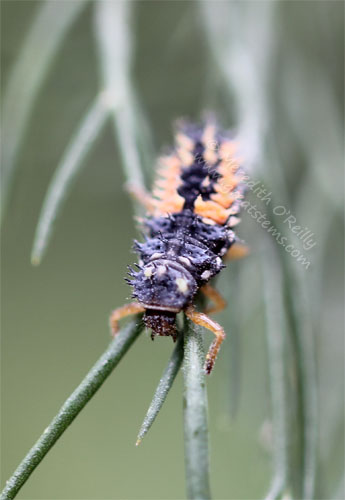 Ladybug larvae are rather alien-like in appearance, but they are gentle little things — well, not to aphids.
Ladybug larvae are rather alien-like in appearance, but they are gentle little things — well, not to aphids.
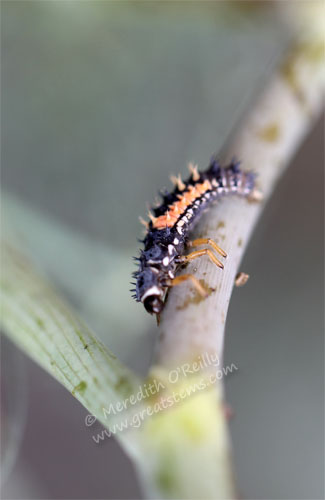
Hey, look at those great legs (or should I say, great stems? hohoho)! I guess my interest in insect legs doesn’t stop with caterpillars.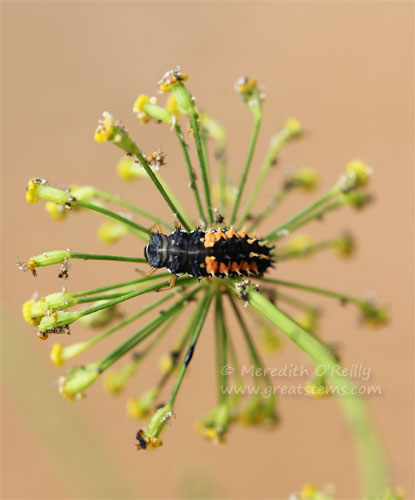
As it turns out, I have a lot of ladybug larvae on my dill. A LOT. And that’s a good thing.
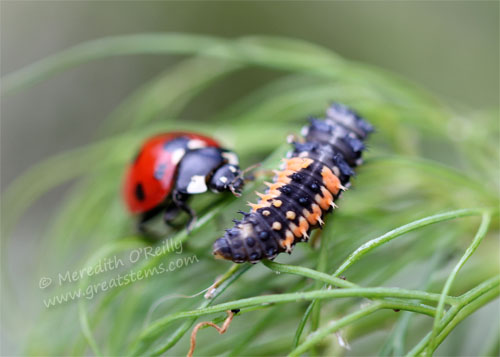
Even so, it wasn’t easy to get a picture of both adult and larval stage together. In fact, right after I took this picture, the larva fled the scene, while the adult seemed to give chase. I have no idea whether there was a threat of predation, but I do know that adult lady beetles consume other insects and larvae, in addition to aphids.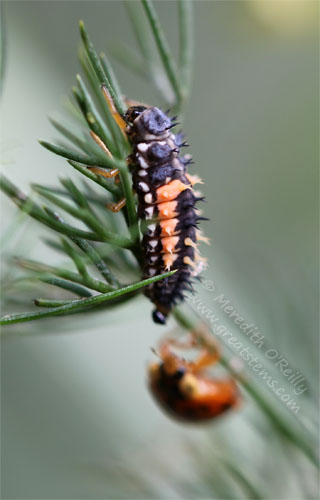
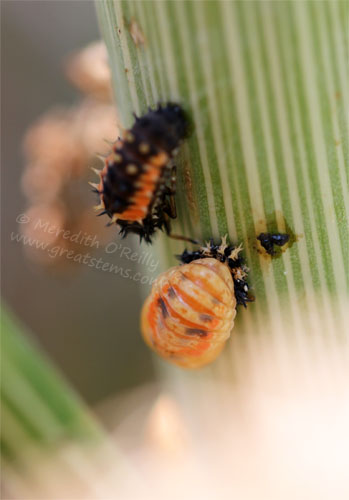
When the lady beetle larva is ready, it will enter its pupa stage. Over the next several days, a complete metamorphosis will take place, and eventually an adult lady beetle will emerge. Above you can see one larva already in pupa stage, the other just starting.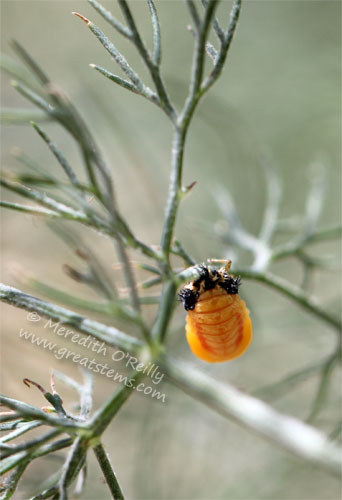
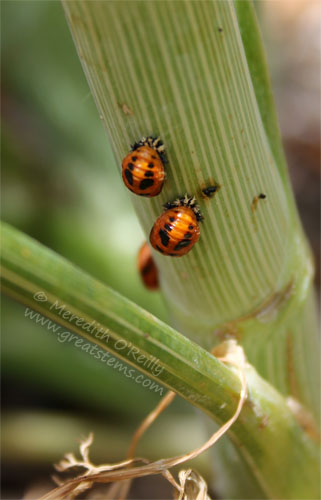
The base of the dill was a popular spot for pupae. Once the adults emerge, it will take a few hours for their exoskeleton to harden and darken. Then it’s time for an aphid feast and getting a new ladybug cycle underway.
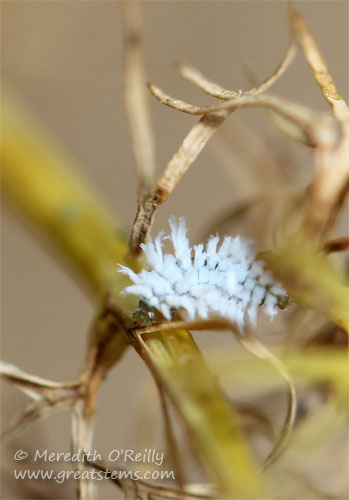
Oh but there’s more! This mealybug destroyer wanted its fair share of aphids, too. Mealybug destroyers (Cryptolaemus montrouzieri) are also members of the lady beetle family. They aren’t native to the states (they were introduced from Australia in 1891 to do exactly what they do — eat mealybugs, aphids, and scale insects), but they seem to be helpful without affecting native populations of lady beetles. They actually look like larger versions of the mealybug pests they are known for eating — this is called aggressive mimicry.
There are other insects taking advantage of the aphid feast offered by the dill, but I’ll stop here. The dill, getting uglier by the day (its prime time is during cooler temperatures), gets to stay, too beneficial a haven to remove.
Just when I think I’ve seen your best photos, you amaze me with these!
Just be glad you didn’t have to scroll through all the many ones that didn’t turn out, Vicki. 🙂
Fabulous pics. Maybe I’ll be able to grow some dill this summer- just made a gardening deal with a staff member here in Montana.
Nice, Marilyn! Enjoy Montana!
The parsley is blooming and all the pollinators are going nuts. The dill is covered in aphids and (seemingly) overnight, the milkweed is free of them. On Saturday I counted 8 ladybug larva on the dill and moved one from the parsley (which doesn’t have aphids) to the milkweed (thus, I’m guessing, the overnight disappearance of the aphids). But I’m in the same boat – I can’t cut back the plants even if I wanted to.
It’s a happy problem to have, Katina!
Where do I begin?!
The photo of the black swallowtail caterpillar from underneath – I’d never thought to look at a caterpillar that way, let alone photograph it, but the result is fascinating!
The ladybug in the center of the dill inflorescence…Such a shining spark of red in the middle of the fireworks explosion!
The wonderful closeups of the all the stages of the ladybug life cycle, including the very different looking male and female mating. (Have you thought about reporting on the ladybug species you see/photograph to the Ladybug Project…or whatever its formal name is?)
And I’ve never seen a mealybug destroyer before – learned something new!
Great post!
You took some fantastic closeups of the mini world on the dill plant, with its own food chain. The swallowtail caterpillar is very cute a it clings to the stem with those chubby appendages. It’s a good thing for your garden that the oblivious ladybug is more intent on its aphid meal, a very good multi-tasker.
Fascinating photos! There have been an abundance of lady bugs in my garden this year as well. They seemed to arrive hungry and ready to feed. Thank goodness, because I don’t remember ever seeing so many aphids. Hopefully, they’ll stick around and keep the spider mites and white fly at bay.
Aphid reproduction is almost scary, efficient that it is, Ally. But this is the first year that I’m seeing the ladybug larvae actually get them under control, at least on the dill. I should move a couple over to the milkweed aphids.